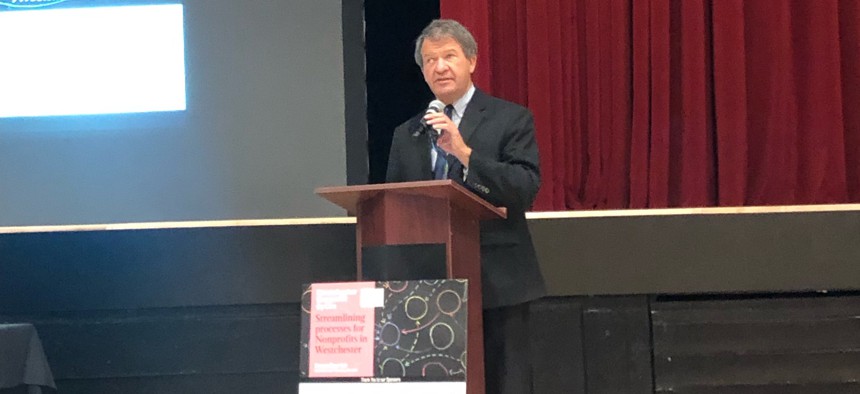Nonprofits
Westchester nonprofit executives weigh in on best practices and leadership
New York Nonprofit Media’s 2023 Westchester OpCon gathered experts and local officials to highlight partnerships, streamlining processes and best fundraising practices.

Westchester County Executive George Latimer speaks to attendees at New York Nonprofit Media’s 2023 Westchester Nonprofit OpCon. Phenix Kim
As many turn to nonprofits to fill gaps when government can’t – these organizaitons are becoming an increasingly significant body of community leadership. To address the unique operational challenges faced by nonprofits, Westchester County leaders, executives and specialists gathered at New York Nonprofit Media’s 2023 Westchester Nonprofit OpCon, held at the Westchester County Center Wednesday. The center, which served as a fully-functioning hospital during the COVID-19 pandemic, became the venue for panelists who addressed streamlining processes, governance practices and equity.
Jan Fisher, executive director of Nonprofit Westchester, remarked on the growing economic presence of nonprofit locally.
“Nonprofit organizations are the lifeblood of our communities, they provide critical care and essential services and we are society's problem solvers. Our sector plays a fundamental role in New York States and Hudson Valley's economy, providing one out of every five non-governmental jobs in the region, $7.4 billion dollars in annual wages, and an estimated $1.1 billion in state and federal payroll tax contributions,” Fisher told attendees. “With Westchester County accounting for nearly half these economic benefits in the Hudson Valley, now more than ever, effective and strong nonprofit organizations are carried out.”
Given that nonprofits often supplement existing government entities, Westchester County Executive George Latimer, stressed the importance of partnerships to harness the skills of such organizations.
“We understand that it is partnership that moves things forward. And in those partnerships, the private sector or organized corporate and individual philanthropy, there is a role that the government plays and there is a role that the not-for-profit community plays,” he said in his remarks at the event. “What we strive for in Westchester is the partnership, not necessarily dominated by the government, but assisted by practical working together.”
Latimer also highlighted the sector’s vast areas of expertise and proximity to the public, both vital to assessing feedback.
“We need to rebuild the bridge. We know we don't have that expertise in house. So we go externally to project out. That's the same mindset that we view our relationships with not-for-profit organizations, that we could not deliver the services that we have to deliver by doing it ourselves,” said Latimer. “Not because our people aren't talented, but the specific expertise that nonprofit organizations, properly structured, can deliver, does on contract and does it better than we can do.” Latimer also pointed to the importance of adapting to technological changes which drive major shifts within the operational landscape of nonprofits.
Panelist Heath Bloch, CEO of Andrus, pointed to increasing transparency when facing workforce challenges in nonprofits. “One of the things that we found was promoting transparency begins to solve some of the workforce challenges,” said Bloch. “By bringing data, where each staff member is ensured that we're all looking at that same data element … [digital transformation] is bringing in a business intelligence tool and partnerships with the private sector to help us become as efficient in using data to make decisions.”
Panelist Corinna Creedon, managing director of FORVIS, noted that central to streamlining practices from communication to technology use, was the importance of building intentional processes. “I think that coming out [of] COVID – everyone was trying to duct tape a solution. And so now, what we're finding is our clients, they are having a little bit of time to catch up and be more reflective and intentional about strategy for digital transformation,” Creedon said.
Creedon continued that this intentional planning must follow within organizational infrastructures to create effective strategies, in addition to thoughtful engagement with stakeholders, both in management and leadership to assess various responses to change.
“Ultimately, we talk a lot about this in our brainstorming, automation and technology,” Creedon stated. “And that modernization is really the best route to ensuring that the execution of the procedures that are needed, in order to be able to make sure that you're in alignment with your policies and permission are accurate or dependable, but you need to make sure that you are thoughtful about it.”
Regarding fundraising, developing fundraising training with board members and increasing accountability were among best practices highlighted by panelist Damian Travier, executive director of Access Psychology Foundation.
“I think it's important to be very intentional about how you engage the board to help them do the best they can to serve you and your bottom line. Another thing that's very important around board members and fundraising is to have their personal commitment,” Travier said. “How do you make sure that they feel responsible for helping you raise the money that's essential for your bottom line for your organization to move forward? You want your board members to be advocates for you, in all of their spaces.”
Building rapport remained important when raising diversity and equity concerns across nonprofit leadership – from choosing board members to instilling a cultural shift within organizations.
“From a work perspective, diversity, equity, inclusion is very intentional, we are intentional about making sure that our work is racially diverse,” Travier explained. “Diverse from any industry in talent perspective, dealing with diverse perspectives – that diversity really lends to robust thought and robust leadership and stewardship of the organization. I think it's important to show that everybody's still engaged and has a voice in the room.”
